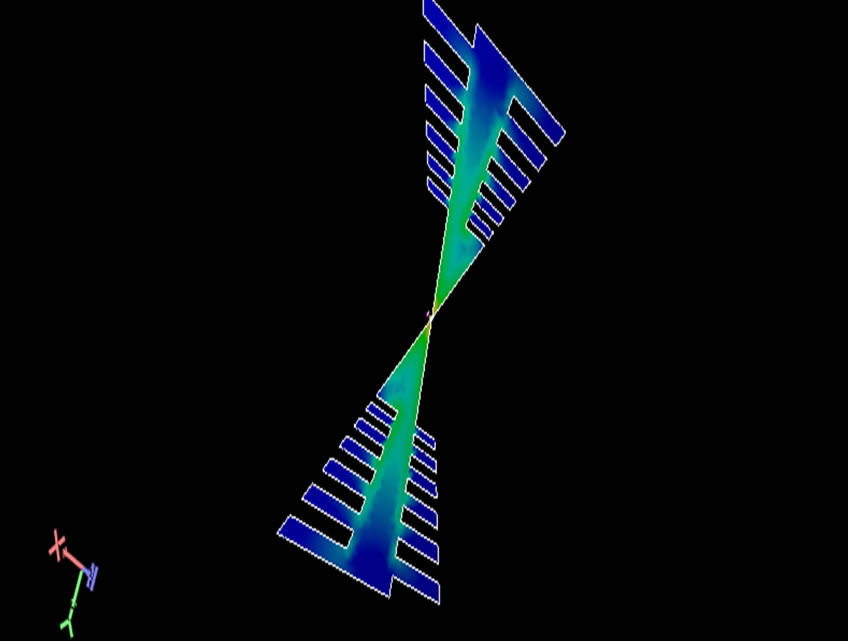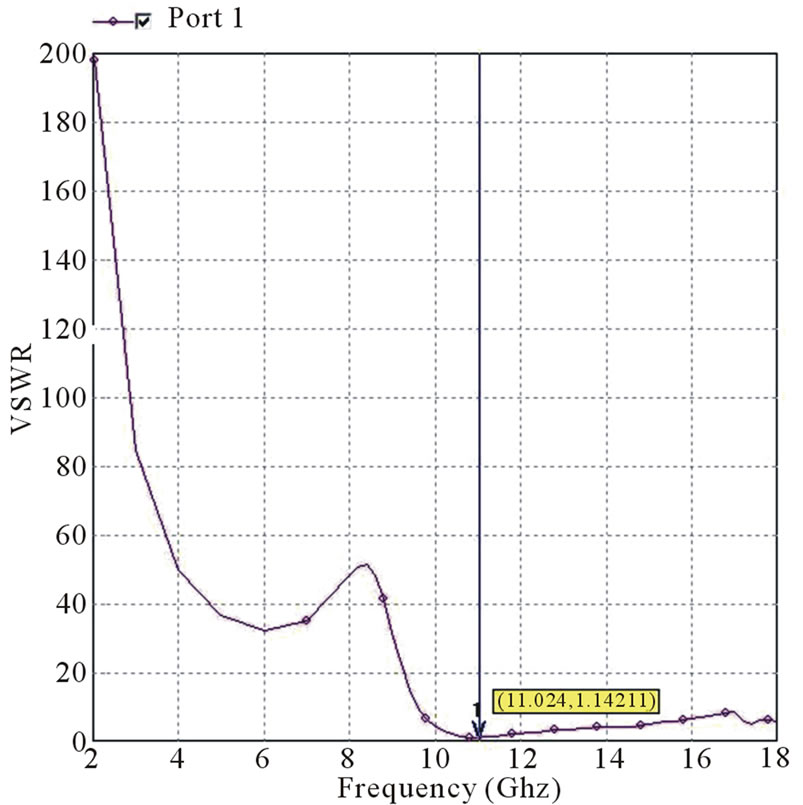History and Advancement of the Family of Log Periodic Toothed Planer Microstrip Antenna ()
1. Introduction
Researches on new types of broadband logarithmically periodic antennas structures are studied. The Log-Periodic Antenna (LPA) is investigated as a new type of antenna, whose properties vary periodically with the logarithm of frequency, and provides wide bandwidth, broad beam width, and high gain. This antenna has smaller transverse dimensions than another antenna types. The antennas have pattern and impedance characteristics which are essentially independent of frequency over theoretically unlimited bandwidths. Data transmission at higher rates requires wider bandwidths for the elements constituting a communication link. This required wideband antennas be designed and used [1,2]. In logarithmically periodic antenna [3], the electrical properties vary with log of operation frequency. The high frequency antenna described by Duhamel and Berry [5,6] was periodic structure in which the dimension of successive sections was increased in geometric progression. The log periodic toothed trapezoidal antenna (LPTTA) can be slightly modified to obtain a refined geometry referred to log periodic zigzag and cross toothed antennas. The different (log periodic toothed antennas) are also specified by angle in a manner similar to the LPTTA described earlier [7-10]. The important feature of these antennas is that they represent an earlier link to the development of log-periodic dipole antenna. The initial design based on the concept of log periodic structure was the log periodic toothed planar antenna following the angle concept, if one tooth has width , the next smaller one is
, the next smaller one is  wide, third is
wide, third is  and so on. Let the width of the widest be sigma1, which is approximately one quarter wavelength corresponding to the lower frequency limit. Then the widest of nth tooth, sigma n
and so on. Let the width of the widest be sigma1, which is approximately one quarter wavelength corresponding to the lower frequency limit. Then the widest of nth tooth, sigma n
 (1)
(1)
where  is a constant representing the geometric ratio of width (n + 1). The tooth’s to width of nth tooth. Taking log on both sides
is a constant representing the geometric ratio of width (n + 1). The tooth’s to width of nth tooth. Taking log on both sides
 (2)
(2)
For a given antenna log and log
and log are constant.
are constant.
Consequently the log of  increases in equal steps with n. That is,
increases in equal steps with n. That is,  increases periodically, hence the name log periodic. It is also implied that whatever the electrical properties the antenna may have at a frequency
increases periodically, hence the name log periodic. It is also implied that whatever the electrical properties the antenna may have at a frequency , will be repeated at frequency given by
, will be repeated at frequency given by
 (3)
(3)
2. Antenna Design
The proposed configuration of antennas along with the same position of the probe feed at origin (0, 0) is shown in Figures 1, 2 and 3. The design of log periodic toothed antennas [11-17] depends upon various parameters such as geometric ratio (τ), tooth width (σ) and angles α, β (alpha, beta). Here we have taken the highest frequency

Figure 1. The proposed configuration of trapezoidal toothed antenna.

Figure 2. The proposed configuration of cross toothed antenna.

Figure 3. The proposed configuration of zigzag toothed antenna.
18 GHz. We have taken frequency range 2 GHz to 18 GHz.
Design for 7 Cells of the Antenna
If we take the 1st cell to be equal to λ/2 then
R6 = 9.8 mm r5 = 10.621 mm
R5 = 11.52 mm r4 = 12.50 mm
R4 = 13.56 mm r3 = 14.705 mm
R3 = 15.95 mm r2 = 17.30 mm
R2 = 18.77 mm r1 = 20.35 mm
R1 = 22.08 mm
Taking τ = 0.85 with α = 60 and β = 20
Dielectric constant (ε) = 4.4
Loss tangent = 0.0002
Z-top = 1.6
3. Result and Discussion
The proposed antenna has been analyzed using IE3D Software using probe feed at (0, 0) [20]. Figures 4, 5 and 6 shows the variations of VSWR with frequency for LPTA for trapezoidal, cross and zigzag geometry. For trapezoidal toothed antenna as we can see from Figure 4 that for frequency 13.0295 GHz to 13.9 GHz the input VSWR is lesser than two (VSWR < 2). This is the usable range of the antenna, i.e. 7% of bandwidth is available. For cross toothed antenna as observed from Figure 5 that for frequency 11.025 GHz to 13.9 GHz the input VSWR is lesser than two (VSWR < 2). This is usable range of the antenna, i.e. 26% of bandwidth is available and for zigzag toothed antenna as observed from Figure 6 that for frequency 10.5 GHz to 16.3 GHz the input VSWR is lesser than two (VSWR < 2). This is the most useful range of the antenna, i.e. 50% of bandwidth is available. With the analysis of the antenna bandwidth it is observed that bandwidth is improved for the geometry of Figures 2 and 3 as compare to Figure 1. Similarly from the gain versus frequency plot in Figures 7, 8 and 9 of the trape-

Figure 4. Plot of VSWR versus frequency of trapezoidal antenna.

Figure 5. Plot of VSWR versus frequency of cross antenna.

Figure 6. Plot of VSWR versus frequency of cross antenna.

Figure 7. Plot of gain versus frequency.

Figure 8. Plot of gain versus frequency for cross toothed antenna.

Figure 9. Plot of gain versus frequency for zigzag toothed antenna.

Figure 10. 3D Radiation pattern of trapezoid toothed antenna.

Figure 11. 3D Radiation pattern of cross toothed antenna.

Figure 12. 3D Radiation pattern of zigzag toothed antenna.

Figure 13. Smith Chart of trapezoidal toothed antenna.

Figure 14. Smith Chart of cross toothed antenna.

Figure 15. Smith Chart of zigzag toothed antenna.
zoidal, cross and zigzag pattern it is observed that the maximum gain is obtained for the zigzag geometry so we can practically implement the zigzag pattern and optimize it for the better results for a wide band usage. The 3D Radiation pattern and smith chart of the proposed trapezoid, cross and zigzag antenna are shown in Figures 10, 11, 12,13, 14 and 15.
4. Conclusions
A log periodic self complementary toothed planer probe feed antennas have been proposed. Log periodic zigzag toothed antenna and Log periodic crossed toothed antenna have better results as compare to the basic geometry as shown in Figure 1. The proposed designs have enhanced bandwidth, gain, radiation pattern and VSWR and similar characteristics throughout the operating bandwidth.
5. Acknowledgements
The author thankfully acknowledges the authorities of Manav Rachna International University, Faridabad, Haryana, for the provision of facility for this research work.